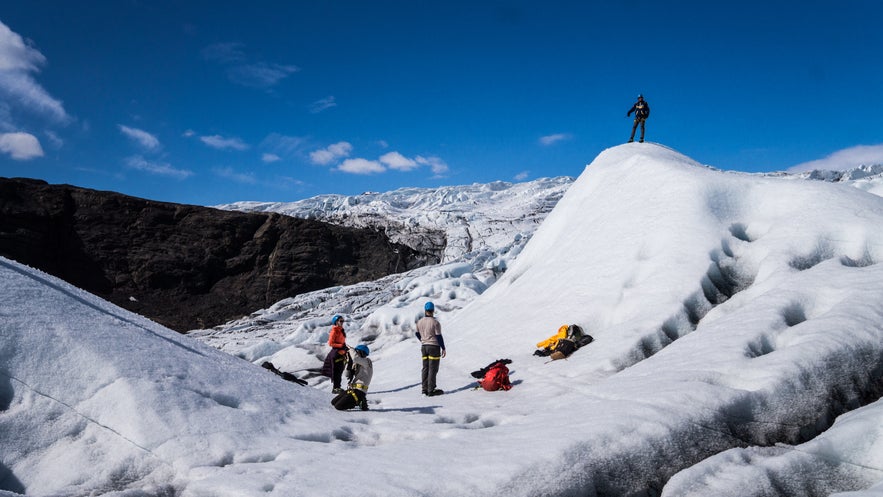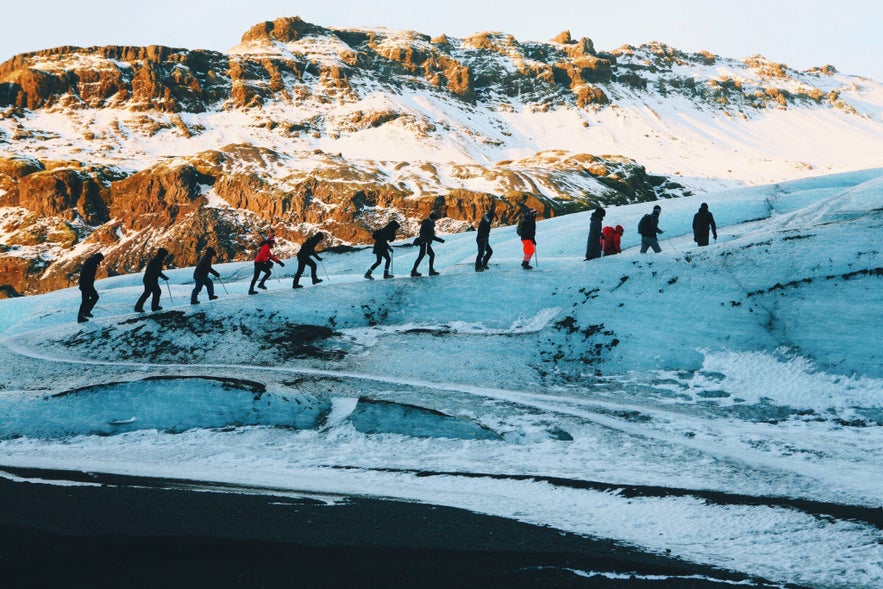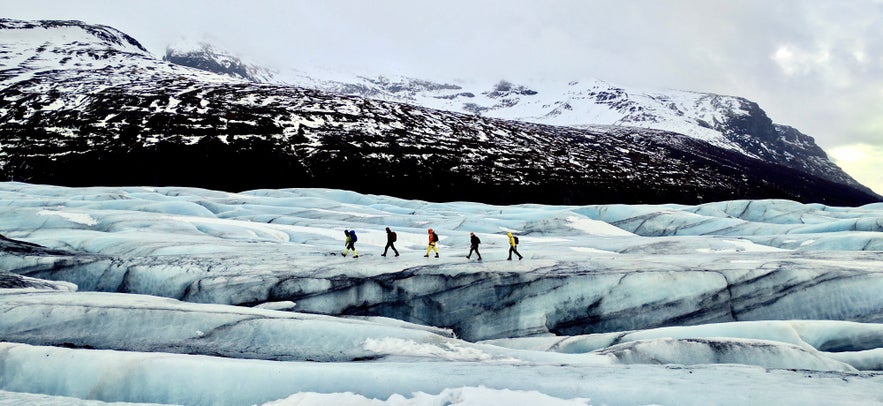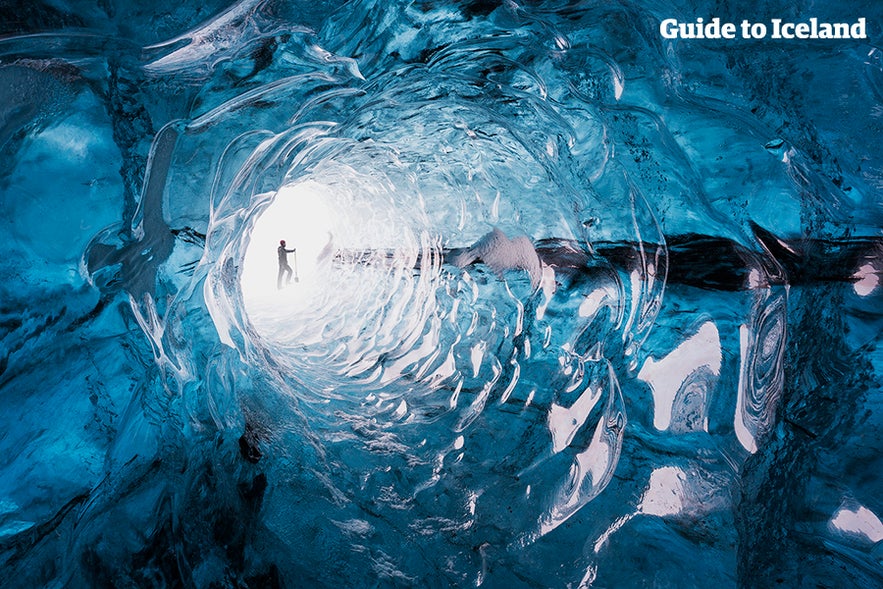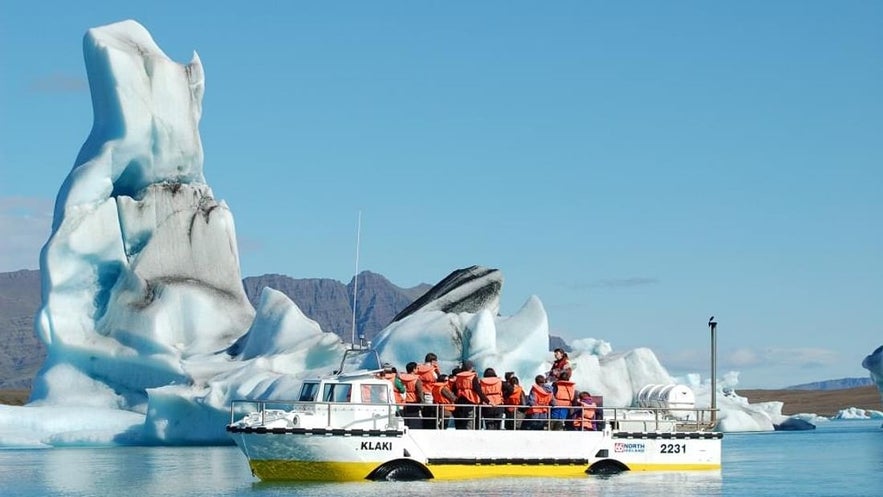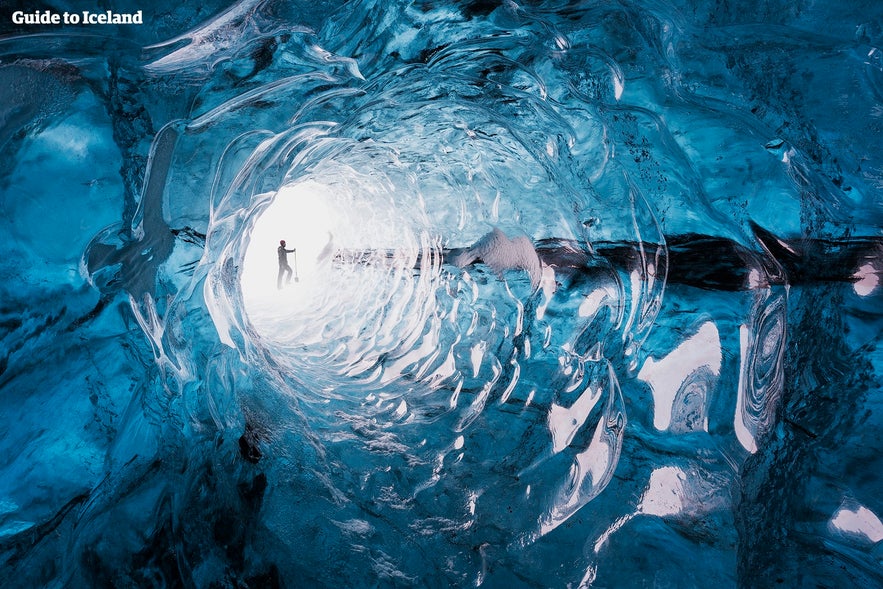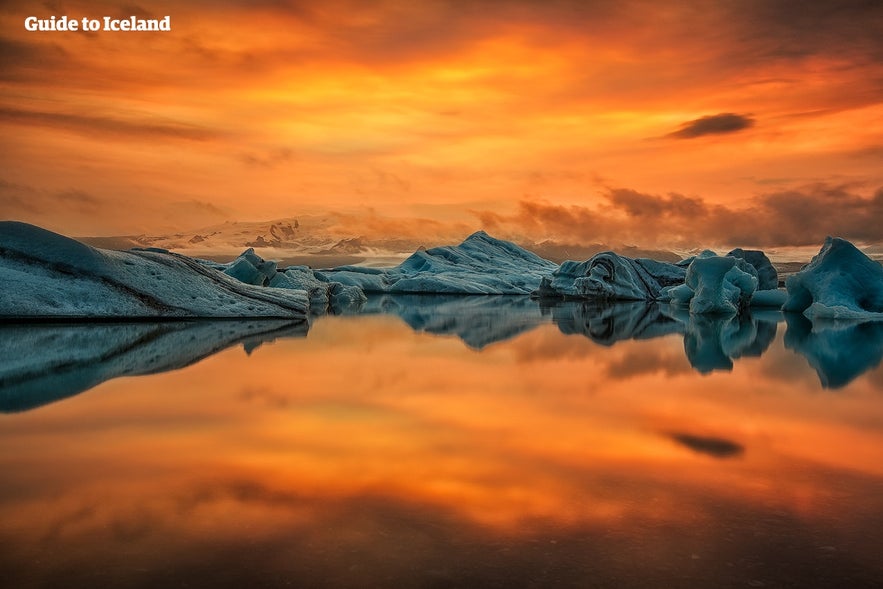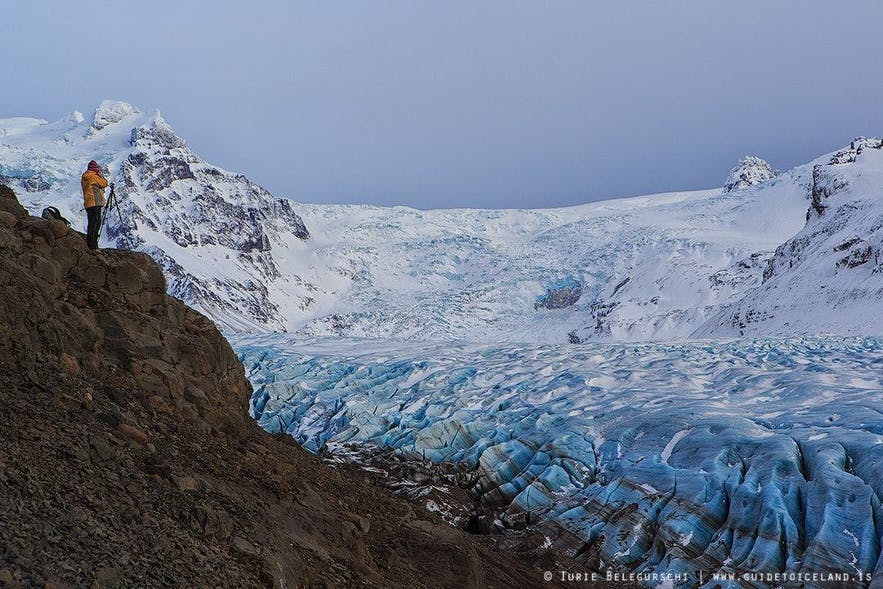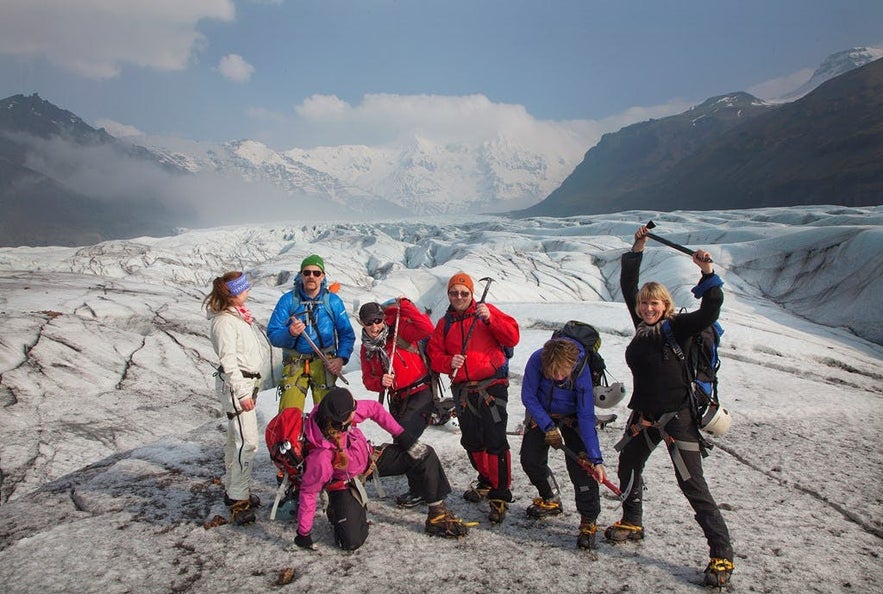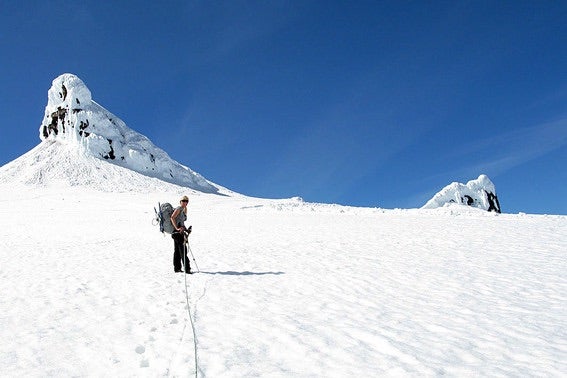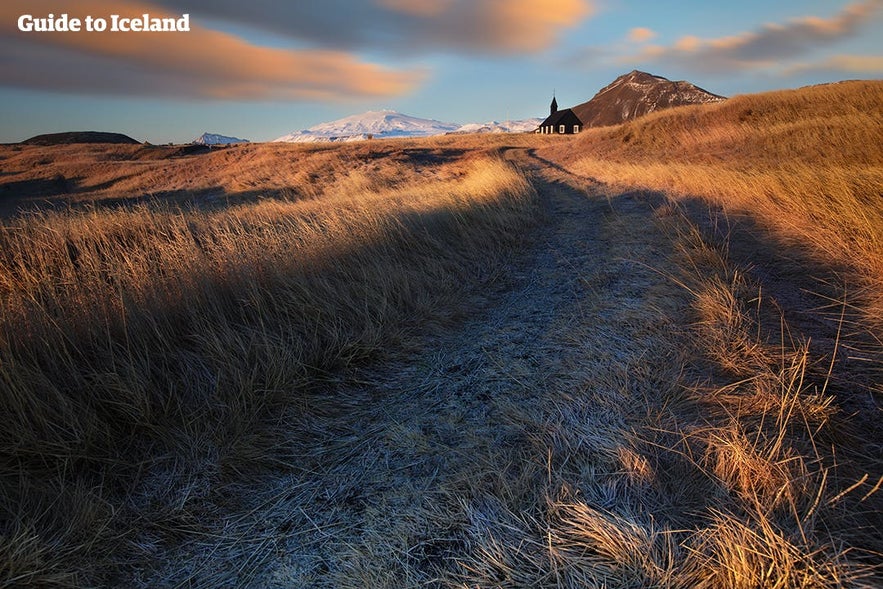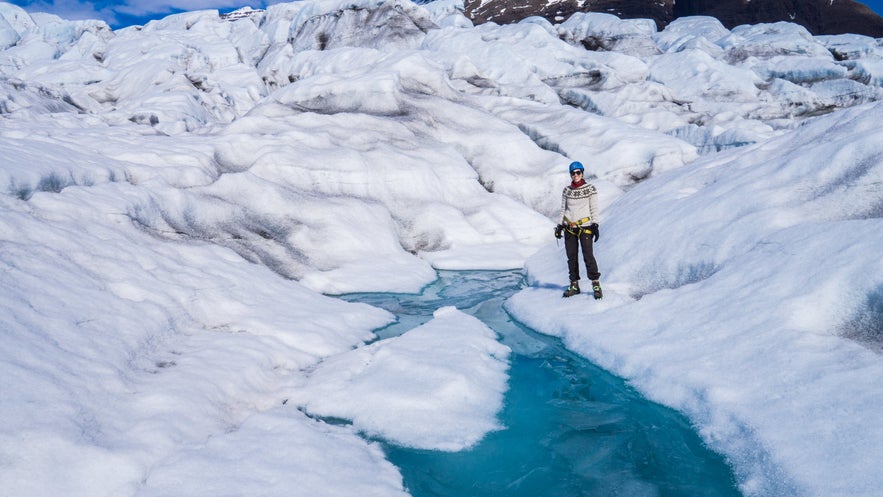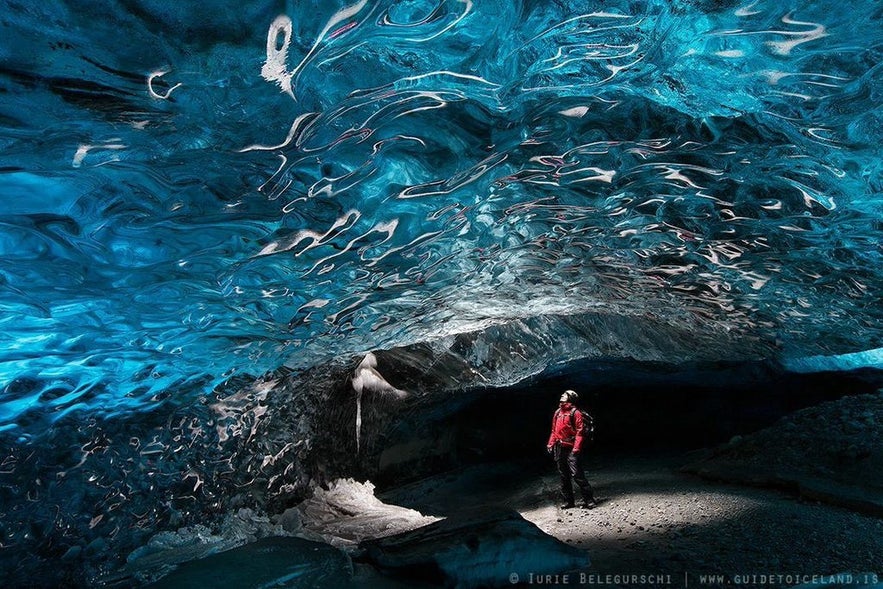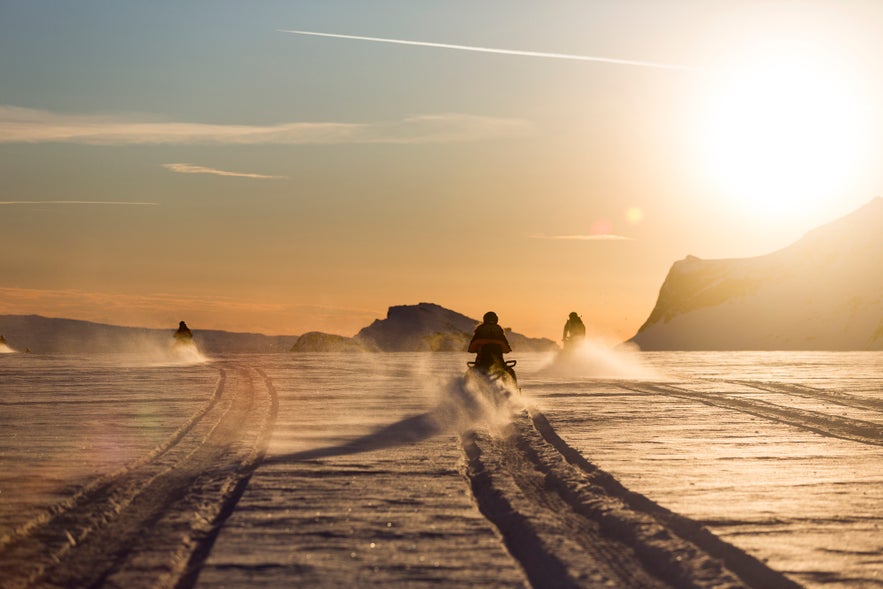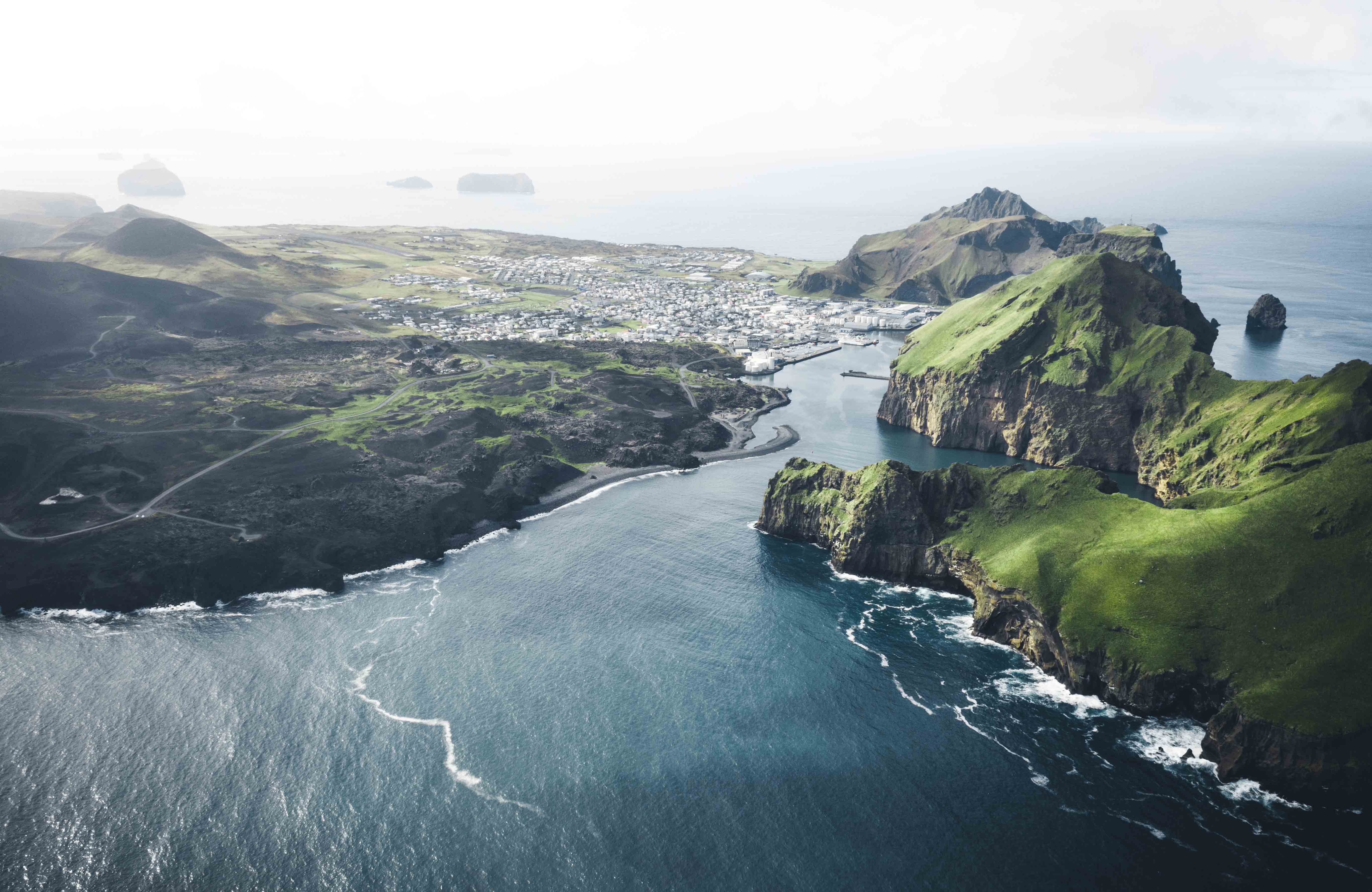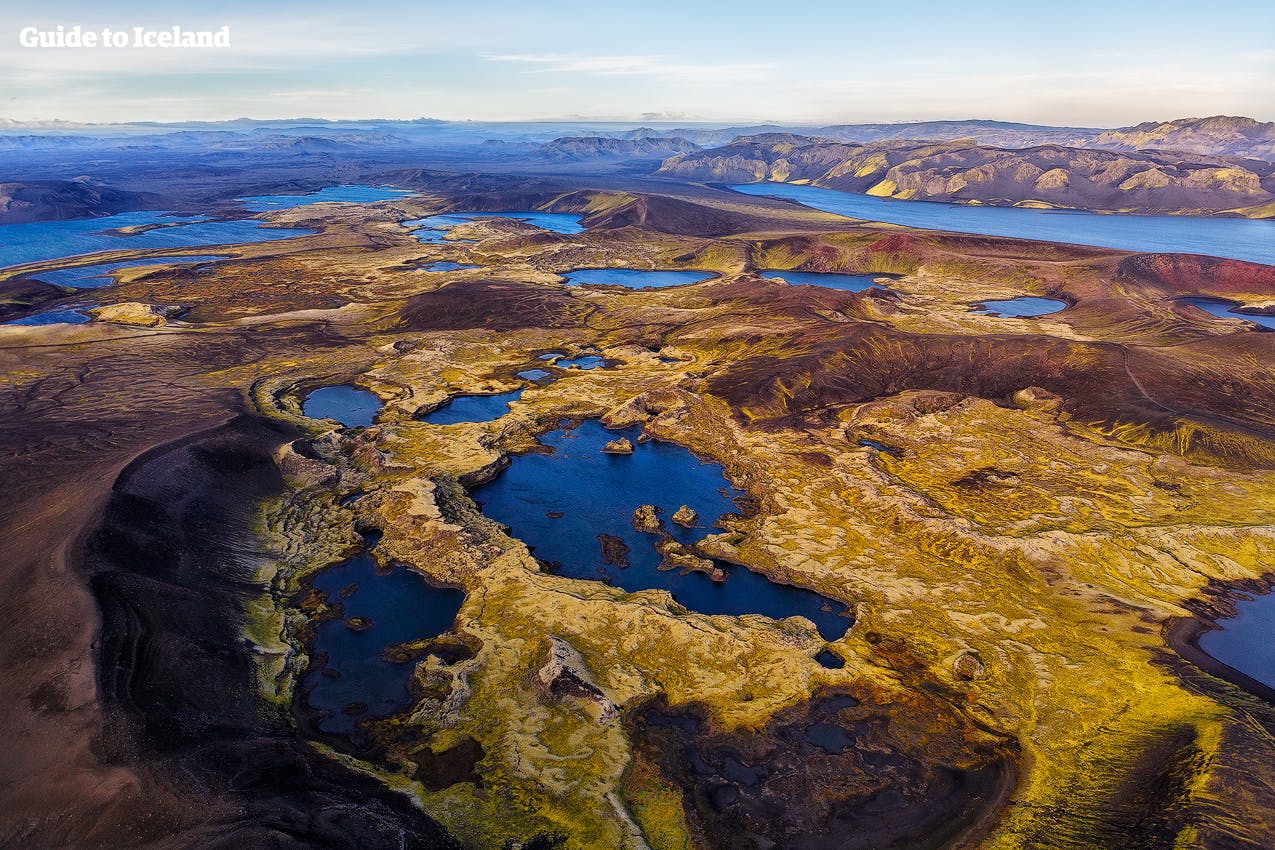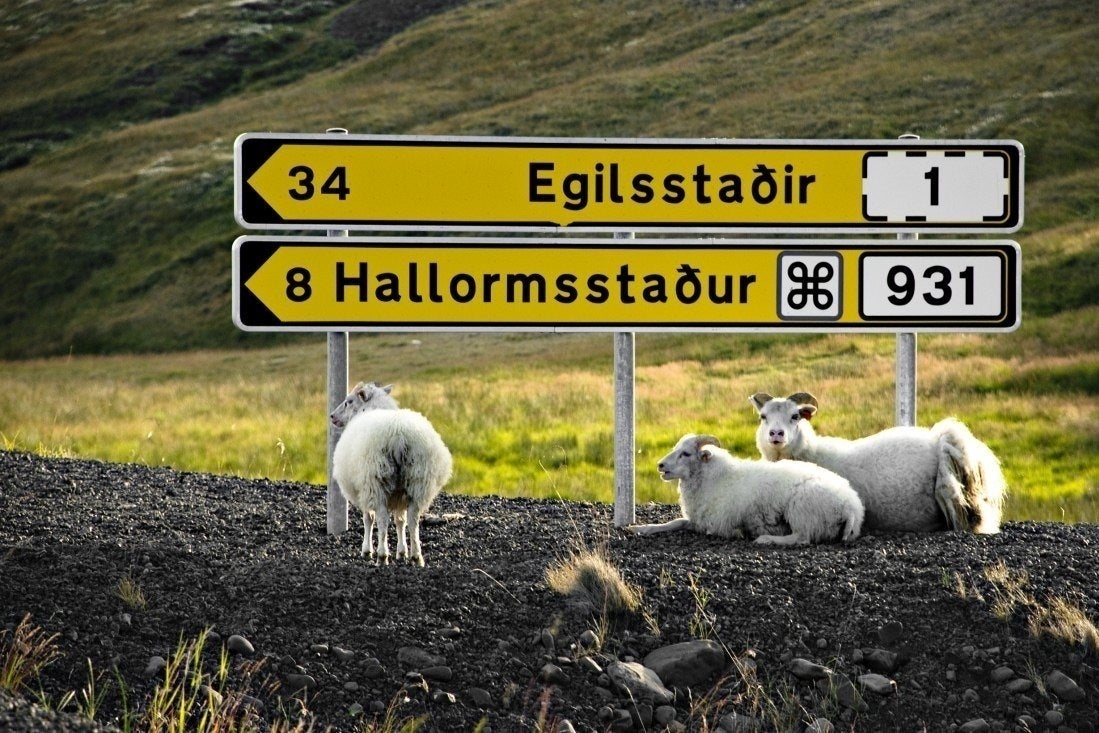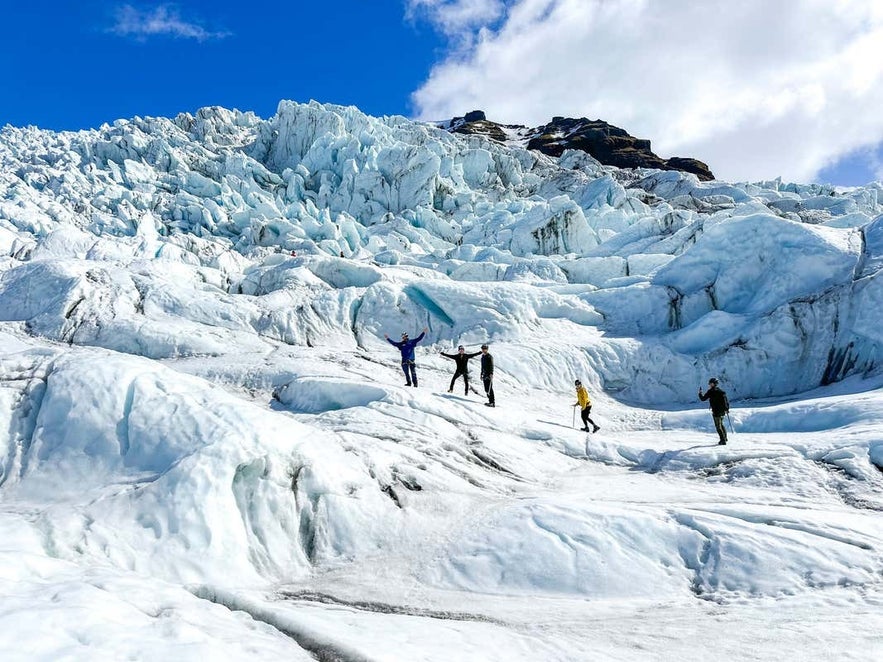
Exploring Iceland's majestic ice caps with glacier tours is an essential adventure during a visit. These massive ice formations, shaped over thousands of years, offer breathtaking views with deep crevasses, vast white landscapes, and vibrant blue ice that seem out of this world!
There are many experiences to choose from, such as this popular 5-hour glacier hiking adventure in Skaftafell Nature Reserve. You'll explore unique ice formations and surreal landscapes in a small-group setting led by professional glacier guides.
Why You Can Trust Our Content
Guide to Iceland is the most trusted travel platform in Iceland, helping millions of visitors each year. All our content is written and reviewed by local experts who are deeply familiar with Iceland. You can count on us for accurate, up-to-date, and trustworthy travel advice.
Depending on the time of your visit, you could also explore an ice cave in the Vatnajokull glacier, known for its striking blue colors! Ice cave tours bring you inside the glacier itself, and they're one of the best experiences you can have in Iceland.
Glacier tours offer unforgettable adventures, as you'll witness some of the most otherworldly landscapes in Iceland. Read on to discover everything you need to know about glacier tours and make your trip to Iceland truly incredible!
All you need to know about Glacier Tours in Iceland
Imagine stepping onto an endless ice field—a thrilling thought that might seem daunting at first. Movies and TV often dramatize glacier adventures with scenes of daring rescues, heart-pounding climbs, and narrow escapes from icy cliffs, making it appear dangerous and intense.
In reality, with the proper equipment, knowledge, and guidance, glacier tours in Iceland are not only safe but also incredibly exhilarating, even for first-timers. Remember, all three of these elements are essential, and exploring an ice cap without them is not recommended. When prepared and led by experienced guides, a glacier tour in Iceland offers a unique adventure that lets you safely experience the breathtaking beauty of these icy giants.
The requirements for joining a glacier tour are pretty straightforward. For most basic hikes, participants must be at least eight to ten years old, such as this beginner-friendly glacier hike tour on Solheimajokull glacier, which allows children from eight years old to join.
For ice climbing tours, participants need to be at least twelve to fourteen, though this varies by tour operator. Ice caving generally requires a minimum age of twelve, while snowmobiling tours require a full international driver’s license for those wanting to drive. Otherwise, participants can join from around six years old as passengers, like with this Langjokull glacier snowmobile tour.
Additionally, you should be in good general health, as walking on ice with specialized equipment can be physically demanding. It’s essential that participants follow their guide’s instructions closely and without hesitation, as glaciers, though safely navigated by experienced guides, carry inherent risks, and safety is the top priority.
- See also: Things That Can Kill You in Iceland
- Read about the 24 Things Not To Do in Iceland
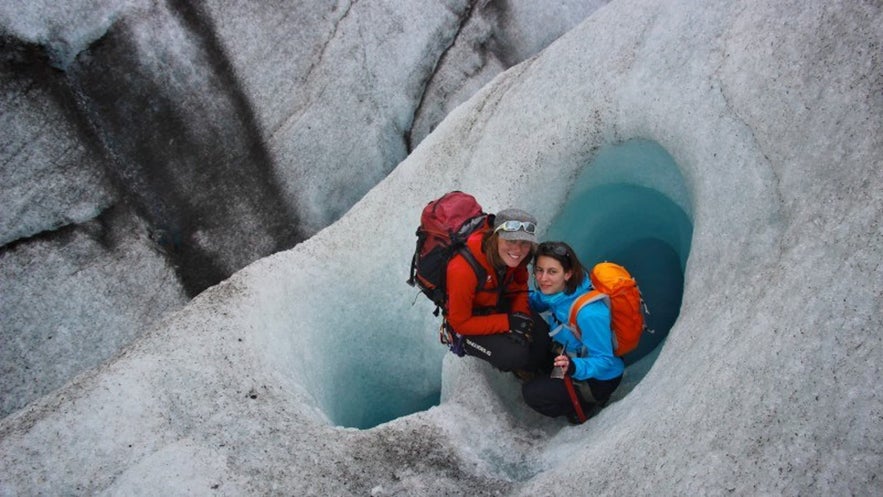
Glacier tours require participants to wear specific safety equipment, which the tour operator provides at the start of the experience. Not every piece of equipment will be used on every tour, but the following list offers a general overview of what to expect. This equipment includes:
-
Crampons: Crampons are spiked attachments that secure your boots, providing stable footing on ice and snow and allowing you to climb icy surfaces safely.
-
Ice axes: Ice axes are essential safety tools that help hikers navigate steep slopes, assist in climbing ice walls, and provide security against sliding in case of a slip. Plus, they make you look pretty cool in photos.
-
Helmet: Helmets for glacier hiking, ice-caving, and ice-climbing allow room for a hat underneath; they’re a standard safety measure to protect against falls and falling ice. Snowmobiling helmets, on the other hand, are specifically designed for that activity, providing enhanced protection suited to the task.
-
Harness with carabiners and various ropes: Harnesses and ropes are primarily used for ice climbing on beginner glacier excursions to prevent injury if you lose your grip and fall. The guide will demonstrate how they function and manage all necessary rope work. On more advanced glacier tours, these harnesses are also used to keep groups safe in challenging weather conditions or in areas where hidden crevasses may lie beneath a thin layer of fresh snow.
- Learn more about What to Wear For Glacier Hikes in Iceland
- See also: What to Wear for Ice Caving in Iceland
All you need to bring are warm, insulating clothes—think wool or fleece, not cotton—with thermals underneath and weather-proof layers on top. A pair of thin gloves will protect your hands, and you’ll be glad to have a hat to keep you warm. Don’t forget sunglasses and sunscreen; the sunlight reflecting off the ice can be surprisingly intense and blinding.
One of the most important items for glacier hikers is a sturdy pair of hiking boots. Crampons won’t work properly on flimsy shoes or trainers, and they can even slip off, posing a danger to anyone below. And, of course, any shoe with a significant heel is definitely a no-go.
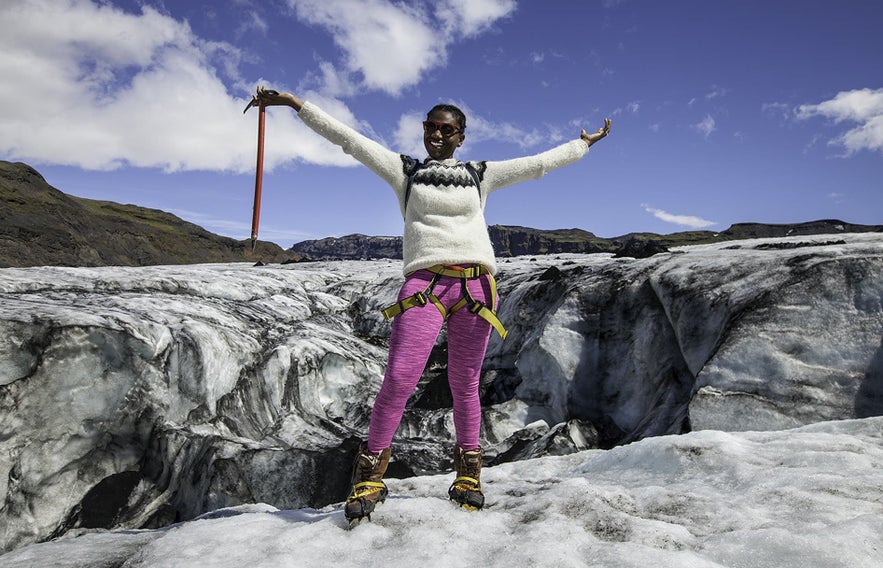
Non-essential gear that you may value includes a walking pole, for those worried they will not be sure enough on their feet, and a camera. There is no doubt that you will wish to capture the unbelievable vistas you will witness from the glacier into something you can look back on for the rest of your life.
- See also: What to Pack For Travel in Iceland
Types of Glacier Tours
Iceland has an amazing lineup of glacier tours, and they’re some of the best ways to experience the country. For many travelers, Iceland’s glaciers end up being the highlight of their trip, and it’s easy to see why—each tour offers a fresh perspective and a new adventure. Whether you’re racing across the ice on a snowmobile or exploring the hidden world of an ice cave, every experience with the glaciers is completely unique and unforgettable.
Some people can’t get enough and try to squeeze in as many glacier activities as possible, while others stick with just one favorite. Either way, it’s good to know exactly what each tour is all about so you can choose the right one for you. Read on to find the perfect glacier adventure waiting for you in Iceland!
Glacier Hiking & Ice Climbing
Glacier Hiking is one of the most popular tour activities in Iceland, encapsulating and bringing forth some of the country’s greatest-known highlights: awe-inspiring nature, thrilling adventure, incredible panoramic vistas, and a whole heap of fun.
For those looking to see the Land of Ice and Fire at its fullest, you shouldn't miss out on the beautiful glaciers, and hiking tours are a fantastic place to begin. Ascending the ice cap, one foot after the other, brings you just about as close as you can to this natural frozen landscape.
The activity is available for beginners, meaning no previous experience hiking glaciers is necessary. At the very beginning of the tour, you will be provided with a safety briefing pointing out some of the potential hazards on the glacier.
To keep it light, your guide will also provide relevant information about Iceland's ice caps, from their formation to their current behavior. They will also give you all the necessary equipment, meaning you will just need to bring sturdy hiking boots and warm clothing.
Discover this beginner-friendly glacier walk tour in Skaftafell Nature Reserve and try out glacier walking for the first time in Iceland.
As an added extra to glacier hiking, many visitors choose to partake in a spot of ice climbing. Iceland's glaciers are not flat but instead characterized by their dramatic slopes, mountainous peaks, and icy valleys.
On this type of tour, there are plenty of opportunities to get the harness out, ready the ice axes, and begin your daring ascent. Throughout the experience, you will be safely attached to both the ice wall and your guide, meaning that should you fall, you'll swing harmlessly to the side.
So, if you are looking for a more challenging adventure on the ice, join this glacier walk and ice-climbing tour at Vatnajokull glacier while on your trip to Iceland!
Glacier Ice Caving
Ice caving is one of the most immersive ways to experience Iceland’s glaciers, taking you right into their depths. Enclosed by ice walls that shimmer in the light, you’ll feel fully embraced by the raw beauty and power of nature. It’s a truly unique experience that lets you connect with Iceland’s glaciers like few other activities can.
Iceland’s ice caves are particularly popular during winter when natural formations display vivid colors and textures. The only natural ice cave tour that is possible to do during the summer months is the iconic Katla Ice Cave tour near the Katla volcano in the Myrdalsjokull glacier. Unlike the intense blues seen in caves in the southeast, this cave has ash layers, giving it a striking, multi-toned appearance that reflects the vibrant and active volcanic history of Iceland.
Many of Iceland’s ice caves are small and isolated, comprised of numerous twisting tunnels and outlets. Others resemble a natural cathedral, with high, sloping ceilings that often allow thin rays of sunlight to illuminate the cave interior, such as what you can experience during this magnificent ice cave tour in Vatnajokull Glacier, which is only available between September and April each year.
This sight creates an ethereal ambiance directly tied to the cave itself; stepping inside, it is as though you are stepping into another world, into the pages of magic and fantasy. Where exactly you can explore while in the cave will be left to the discretion of your guide, who will be ever watchful for both weak points in the ice and exciting points of entry.
Glacier Snowmobiling
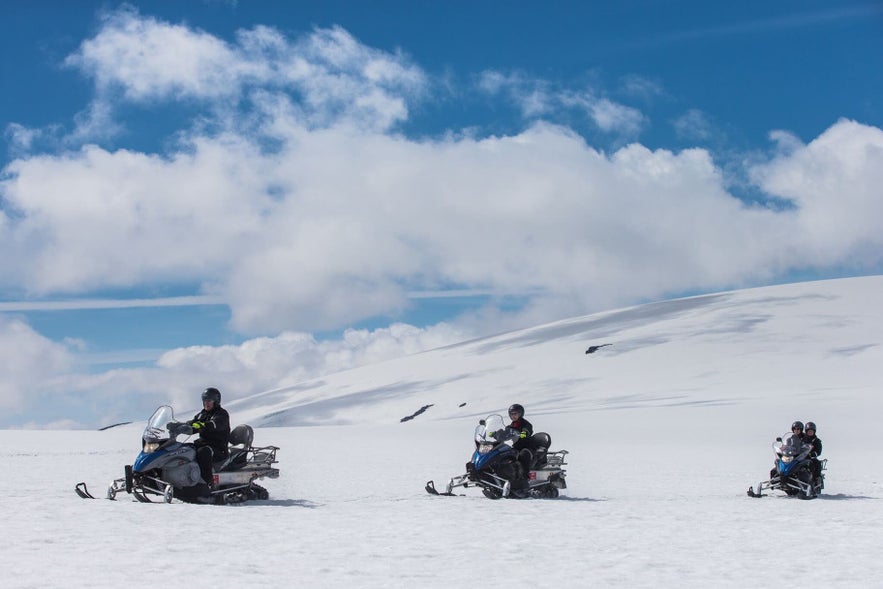
Snowmobiling in Iceland has firmly established itself as a main adventure experience on the island, and it’s easy to see why. Racing across ancient, frostbitten plains, snowmobiling offers a powerful sense of the glacier's sheer scale and beauty.
With your hand on the steering wheel, you’ll feel like you could ride endlessly—these glaciers stretch as far as the eye can see. Snowmobiling perfectly balances adrenaline-pumping excitement with breathtaking scenery, making it a favorite for those seeking both thrill and beauty.
Many snowmobiling tours also include a Super Jeep ride to reach the base camp or the starting point on the glacier, such as this thrilling three-hour super jeep tour with glacier snowmobiling in Vatnajokull glacier.
This adventurous journey takes you over raw frozen terrain and icy paths, bringing you into Iceland’s wild landscapes. Enjoy the views as you ride across the glacier, heading toward the wide, open ice cap ahead.
Glacial Lagoon Boat Tours
One of the more unique ways to experience Iceland’s glaciers is by boat. Now, I can hear what you’re saying. How does one boat sit on an ice cap? Well, in fact, given the sheer size of Iceland’s ice caps, the large amount of meltwater accumulates into some truly stunning glacial lagoons, naturally found at the base of each ice cap.
The most famous of these, Jokulsarlon glacier lagoon, is sometimes referred to as “The Crown Jewel of Iceland,” given its breathtaking aesthetic beauty. However, there are a number of other, often overlooked lagoons found across the country, including Breidarlon, Fjallsarlon, and Graenalon.
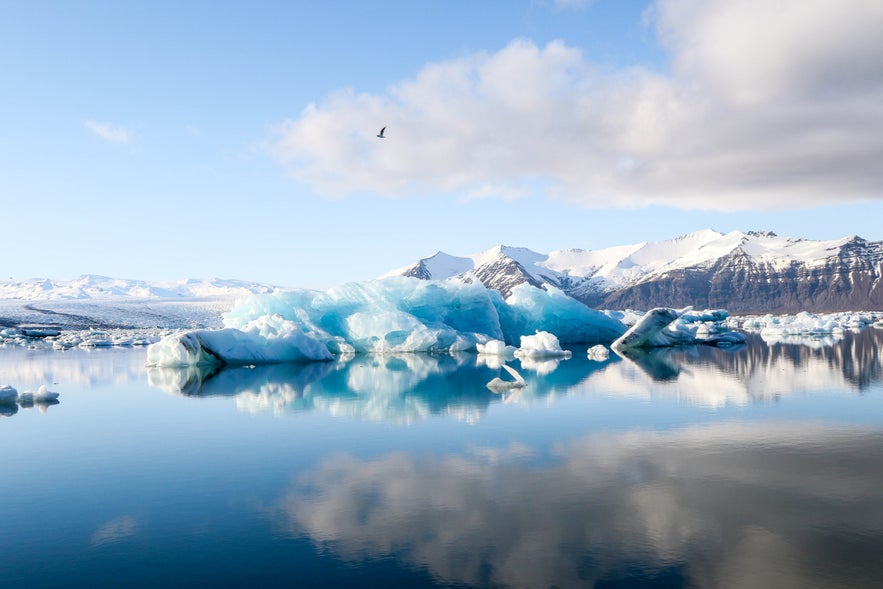 Boat tours allow visitors to get so close to the glacier's icebergs that they can almost touch them, such as during this highly recommended Zodiac boat tour in Jokulsarlon. They will also gain a closer perspective of the glacial lagoon's wildlife, its curious seal population, and its wealth of divebombing sea-birds.
Boat tours allow visitors to get so close to the glacier's icebergs that they can almost touch them, such as during this highly recommended Zodiac boat tour in Jokulsarlon. They will also gain a closer perspective of the glacial lagoon's wildlife, its curious seal population, and its wealth of divebombing sea-birds.
At Jokulsarlon, visitors can hop aboard an amphibious vessel capable of sailing and rolling on land or a speedy Zodiac boat, adding a level of adrenaline to their time on the water.
Glacier Super Jeep Adventures

Super Jeep tours in Iceland offer an amazing and unforgettable experience, combining rugged adventure with the stunning scenery of Iceland’s diverse landscapes. These powerful 4x4 vehicles have become icons in Icelandic tourism, as they’re perfectly suited for Iceland’s unique and challenging terrain. For journeys to glaciers and remote areas, Super Jeeps are essential, making them the ultimate choice for thrill-seekers and nature lovers alike.
With seating for usually up to six passengers, Super Jeeps provide an intimate and personalized tour experience that larger vehicles simply can’t match. Although they come at a higher cost per passenger, the exclusivity and tailored feel make them well worth it. For solo travelers, operators often wait until all seats are filled, ensuring an engaging group experience.
While some may expect Super Jeeps to travel off-road, it’s important to note that off-road driving is strictly prohibited in Iceland to protect its delicate ecosystem. Instead, you’ll journey along mountain tracks that are accessible only to Super Jeeps, giving you the thrill of an off-road adventure while preserving Iceland’s pristine environment.
Embark on a thrilling Super Jepp adventure to Langjokull glacier on this 10-hour tour and discover the majestic landscapes of West Iceland.
The Glaciers of Iceland
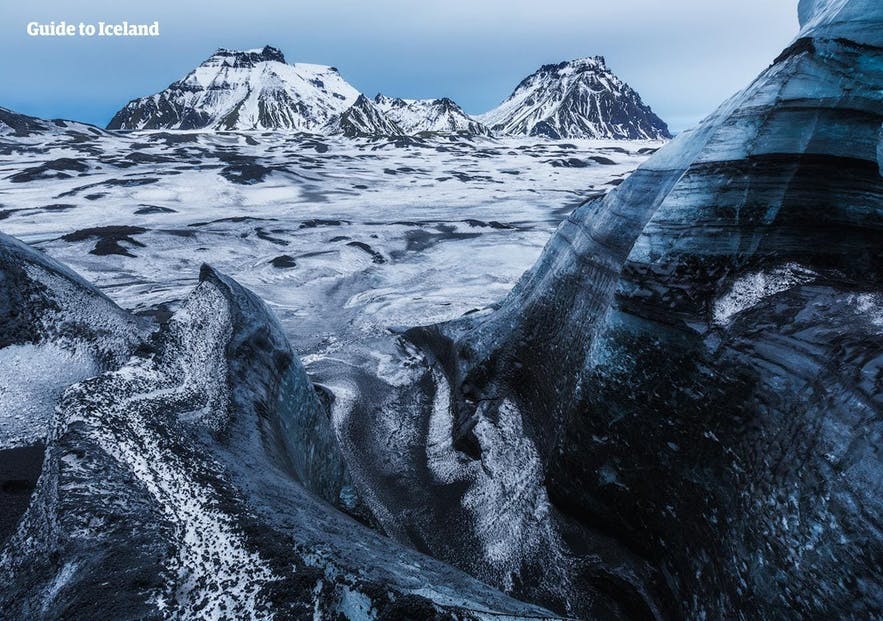
Iceland’s cold, wet weather and many mountains provide the perfect conditions for glaciers to form; there is an abundance of them across the country, with many close to Reykjavik. They include the largest and second-largest glaciers in Europe, Vatnajokull, and Langjokull, respectively.
The glaciers of Iceland have many features that make them incredibly special. One of these is their coloration. True glaciers (which exclude rock glaciers) are predominantly white because they consist of compacted snow.
When ice deforms under intense pressure, however, it becomes so dense that it forces all air particles out of it. This gives parts of some glaciers an electric blue color that is so vivid and ethereal that it barely appears natural. Because of Iceland’s raw volcanism, much of the ice also veined with black ash, some of which dates back centuries.
- See also: Volcanoes in Iceland
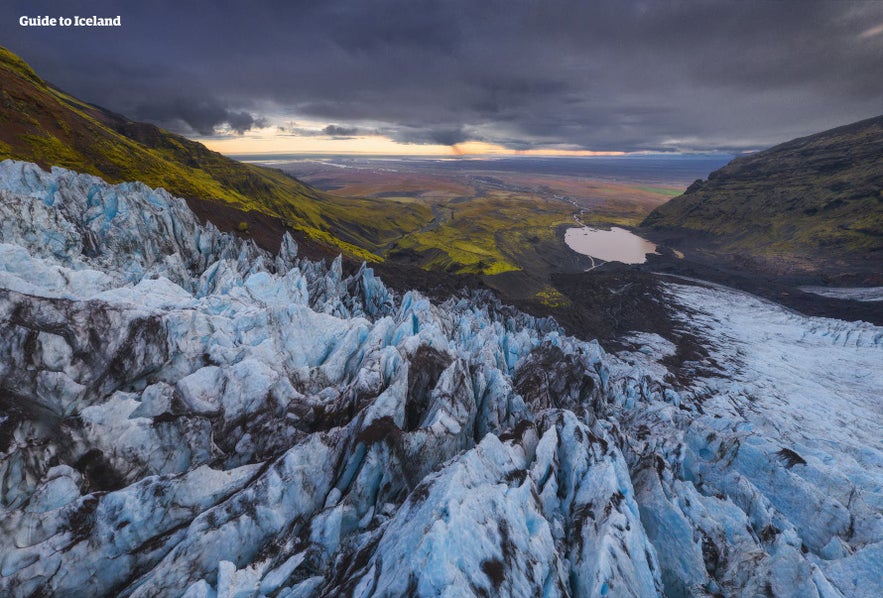
These veins of ash are just one example of why glaciers fascinate scientists. They freeze history within their bodies, and through their layers, experts can discover a wealth of knowledge about climate conditions, geological events, and even ancient life in times gone by.
Considering that some glaciers are potentially millions of years old, they are essential for understanding so much about the history of the world. Iceland’s glaciers started forming 2,500 years ago but still hold a huge wealth of knowledge.
It is possible to see these layers of history without damaging glaciers by exploring their crevasses; these are the deep, vertical cracks that open due to the tensile strain caused by glacial movement. While amateur glacier hikers will not be descending into these openings or even getting close to them, they provide an excellent research tool for scientists.
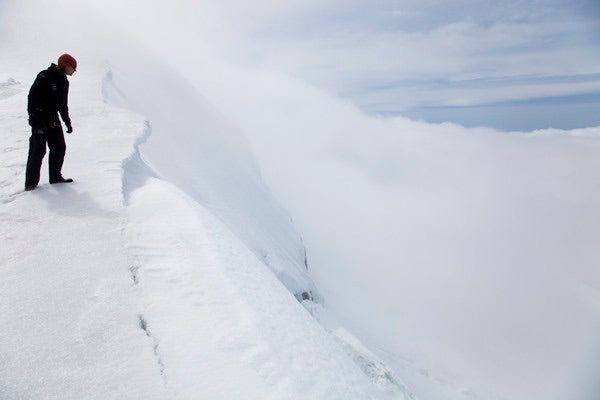
Water that enters these crevasses often erodes its way out of the glacier, creating another incredible feature: ice caves. These unreal formations are sought after by many visitors coming to Iceland during the winter months, and their beauty is otherworldly.
To many, they are the most magnificent sight to be had in all of Iceland. Ice caves are very dependent on conditions, however, and do not form every year or necessarily last throughout.
Those who do not give the ice caves the title of ‘the most beautiful sight in Iceland’ will most likely credit it to Jokuksarlon glacier lagoon.
Glacier lagoons, or glacier lakes, are formed by retreating glaciers and filled with their meltwater. They are often small and dirty due to the sediments that were frozen in the ice. Jokulsarlon, however, is vast, blue, and beautiful and filled with massive icebergs breaking off from a glacial tongue.
- See also: Amazing Aquamarine Ice Caves in Vatnajokull Glacier
- See also: Jokulsarlon Glacier Lagoon - the Crown Jewel of Iceland's Nature
With the many gorgeous features caused by the glaciers and their accessibility, there has been a surge in tourist infrastructure to allow people to explore them in the manner that they like. Tours to the ice caves, trips to the glacier lagoon, and snowmobiling excursions are all popular options.
However, many will likely argue that there is no better choice than to fully appreciate and learn about the glaciers than to partake in a glacier hike.
What is a Glacier?

A glacier, put simply, is a body of ice that exists throughout the year and is constantly moving under its own weight. Over time, often centuries, in areas where there is more snow falling than melting, snow will slowly compact into a single, icy structure. This occurs mostly over mountain ranges and around the poles.
Glaciers move for a variety of reasons. The force of gravity pulls them down, and either because the weight of the ice causes internal deformation or because the land underneath is lubricated with liquid water, they start to slide. This distinguishes a glacier from, say, a lake that is frozen all year or sea ice.
The term ‘ice cap’ refers to a glacier, or a set of conjoining glaciers, that are less than 20,000 square miles (50,000 square km). All of Iceland’s glaciers fall into this category. ‘Ice sheets’ are glaciers that cover a larger area and can only be found in the Antarctic and Greenland.
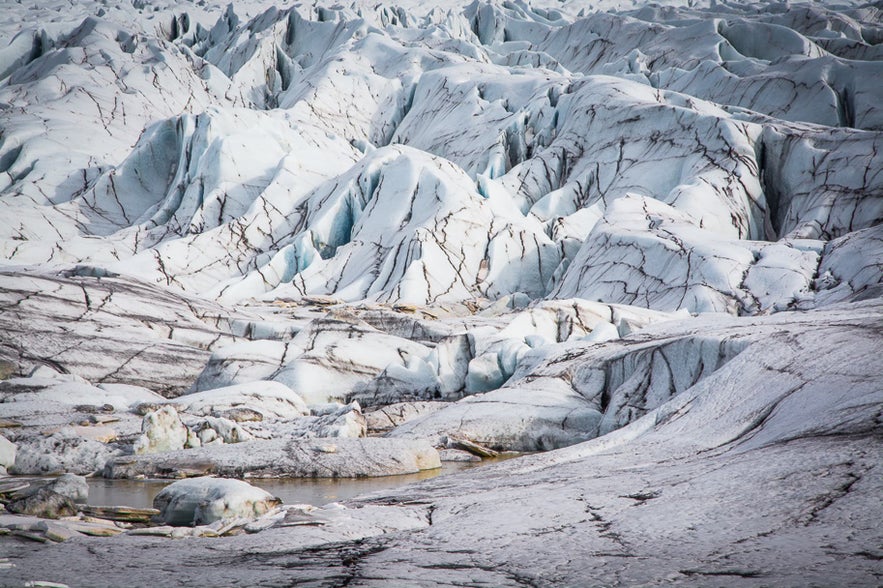
Some glaciers are shrinking due to disappearing within years, while others are defying expectations and growing. Some consist almost entirely of freshwater; others are described as rock glaciers due to the amount of sediment and debris frozen into their ice.
It is rather telling of the glacier tour opportunities in Iceland that it is a temperate country with 11% of its land surface covered in glaciers.
How To Go on Glacier Tours in Iceland
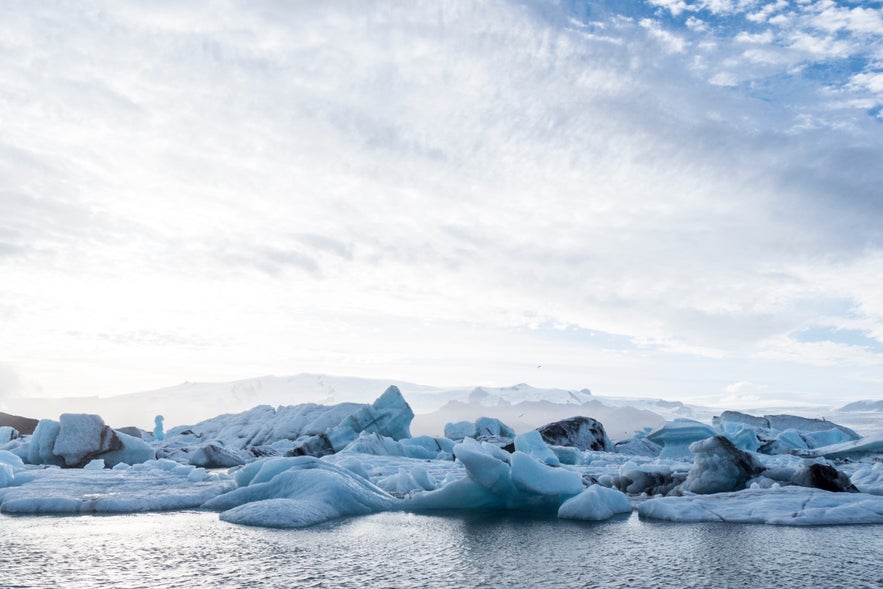 You'll find that the starting point for a lot of glacier tours is along the beautiful South Coast, where accessing many of Iceland's glaciers is easiest Popular destinations include Popular locations include the Solheimajokull, Myrdalsjokull, and Langjokull glaciers, along with the Skaftafell Nature Reserve, the Vatnajokull glacier, and the Jokulsarlon Glacier Lagoon, all within a day’s drive from Reykjavik.
You'll find that the starting point for a lot of glacier tours is along the beautiful South Coast, where accessing many of Iceland's glaciers is easiest Popular destinations include Popular locations include the Solheimajokull, Myrdalsjokull, and Langjokull glaciers, along with the Skaftafell Nature Reserve, the Vatnajokull glacier, and the Jokulsarlon Glacier Lagoon, all within a day’s drive from Reykjavik.
Many South Coast tours offer a glacier or ice cave visit, such as this highly rated 12-hour minibus tour from Reykjavik. However, the region has so much to offer that a single day may not be enough!
Staying overnight at one of the South Coast hotels is highly recommended, especially if you’re planning to book tours by the Jokulsarlon Glacier Lagoon.
For more flexibility, self-drive tours are a great option, allowing you to explore the region at your own pace with a rental car. While it’s possible to experience a glacier tour on a day trip, taking extra time to fully explore the South Coast will make your visit even more rewarding.
The Best Time for Glacier Tours in Iceland
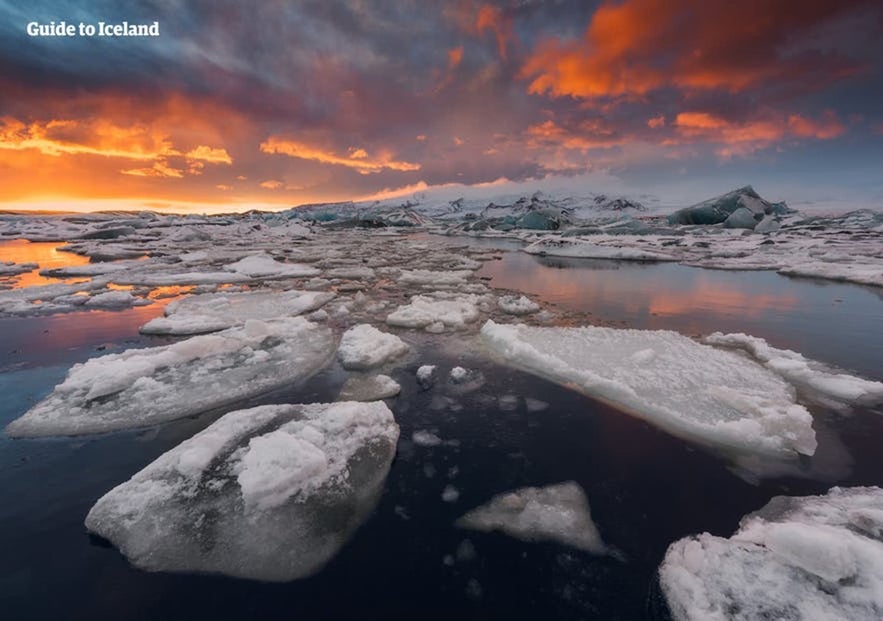
Most glacier hikes can be enjoyed throughout the year, but there are undeniable advantages to doing it in different seasons. Iceland really only has a summer that runs from May to September and a winter that runs from October to April, and the glaciers are vastly different throughout both of these times.
Glacier Tours in Summer
Partaking in glacier tours in the summer has some very obvious advantages. Firstly, the conditions are likely to be a lot more pleasant. While Iceland can be windy, rainy, and cloudy at any time of the year, any adverse conditions will be a lot more bearable in the warmer months. Furthermore, you are much more likely to be able to enjoy sunlight as you hike at this time.
Decent weather means that you will often be able to hike in much more comfortable clothes (although you should bring warm, waterproof layers as insurance, of course) and will not have to cut your tour short if somebody cannot handle the cold.
It also means that any reserved glacier hikes, cave explorations, or snowmobile trips are much less likely to be rearranged due to conditions, which is perfect for those who have a tight schedule for their holidays.
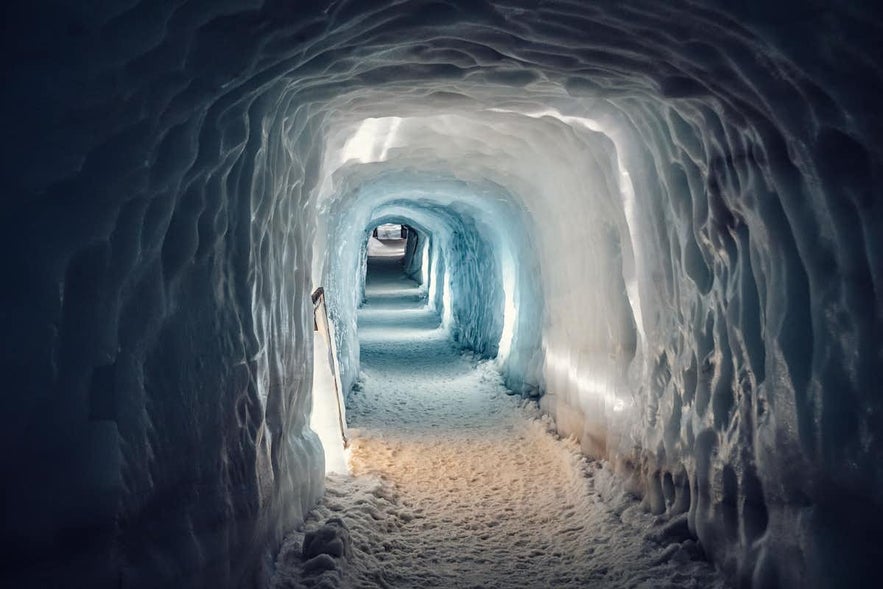
Clear weather also means the views of the landscapes surrounding the glaciers will be even better, whether you are looking across the verdant south, stunning Skaftafell Reserve, or the Snaefellsnes peninsula. As will be discussed in more detail below, Iceland’s glaciers are positioned in very scenic places.
The chance to witness great views also applies when traveling to and from the ice caps; the extended sunlight hours mean no landscapes will be obscured as you travel. As there are only four hours of sun in the depths of winter, your journeys in this time will need to be taken in darkness so you can make the most of the glacier there.
The final reason why summer is advantageous over winter is the greater selection of glaciers you can hike. While the most popular, Solheimajokull and Svinafellsjokull, are open throughout the year, more tours run a day throughout summer, and Snaefellsjokull is only accessible in this season.
Glacier Tours in Winter

Looking at the advantages of glacier tours in summer, you may understandably think it is obviously the best season to do it. You would, however, be quite mistaken.
Yes, in winter, more glacier tours are canceled due to adverse weather, the experience is often more cold and challenging, and the views are often obscured by darkness or cloud cover. The glaciers themselves, however, are infinitesimally more beautiful.
The summer sun melts the outer ice of a glacier, revealing beneath it the layers of ash from eruptions that date back centuries; they, therefore, have large patches and streaks of grey and black running through the white snow.
Though fascinating, it means the glaciers are not as beautiful as when they are armored in newly frozen ice, as happens in winter. This ice is a striking, electric blue, so vivid that it barely seems natural.
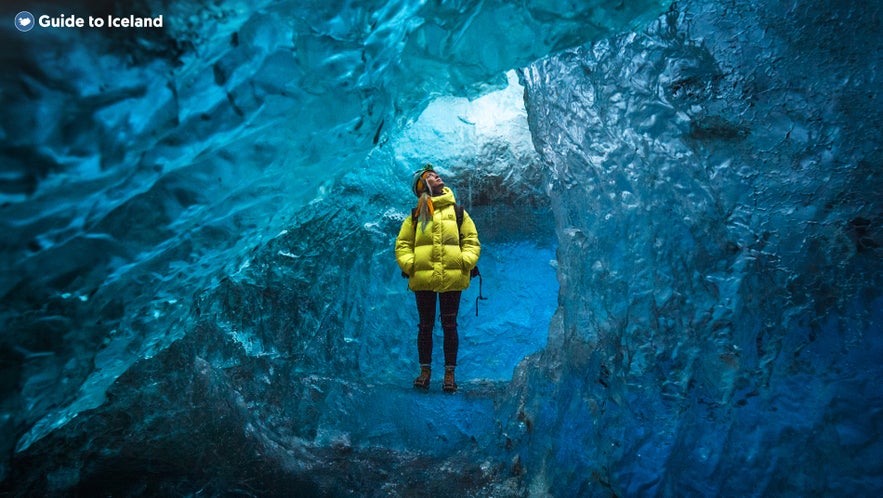 The unreal, ethereal beauty of the ice is not the only advantage of glacier tours in winter, however. If the weather is clear, then embarking on this activity will expose you to dramatic landscapes coated in gleaming snow.
The unreal, ethereal beauty of the ice is not the only advantage of glacier tours in winter, however. If the weather is clear, then embarking on this activity will expose you to dramatic landscapes coated in gleaming snow.
Such beautiful arctic vistas will leave you in no doubt as to why the producers of HBO’s Game of Thrones used Iceland to shoot many of the scenes North of the Wall.
Finally, glacier tours in Iceland in winter can be a lot more fun for the adventurous seeking a challenge. While the ice caps are reasonably accessible in summer, it can be very rewarding to brave them in winter conditions, especially if you combine the activity with a daring ice climb.
What are the best places to go for glacier tours in Iceland?
There are many glacier tour opportunities in Iceland, and the choice can be a little overwhelming. Each glacier has its own distinct charm, and even those that cannot be easily hiked can often be explored in other ways, be it through venturing inside with an ice-climbing tour, flying over above with an aerial sightseeing excursion, or tackling the snowy plains on your own snowmobile.
Glacier Tours on Solheimajokull
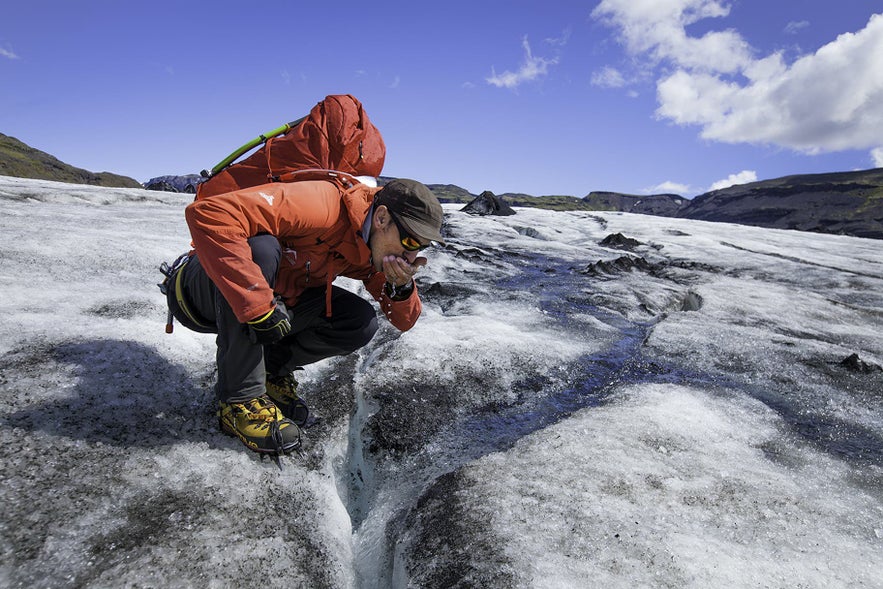
If you are based in Reykjavik, there are daily tours from many providers that take you to the glacier Solheimajokull on the South Coast. These tours are available year-round.
Their popularity stems from the fact that this glacier is accessible for beginners and can be found only a few hours’ drive from Reykjavik. The trip is very scenic, passing by beautiful sites such as the waterfalls Seljalandsfoss and Skogafoss.
Trips up Solheimajokull are perfect for those who simply want to try glacier hiking, learn about the glaciers, and get some great views without any extra frills. Most of these tours have the option for a pick-up from Reykjavik; if you choose to rent a car, you can organize a meeting with your guide and group on location.
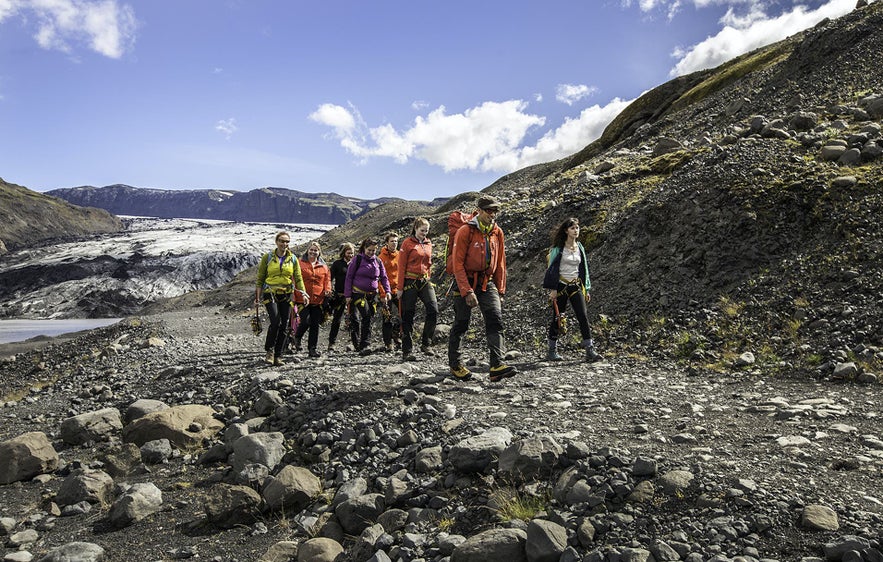
The advantages of Solheimajokull over other glaciers are threefold. Firstly, it is close to the capital; secondly, it is in a beautiful region; and thirdly, the narrowness of its formation makes ice-climbing easier and more enjoyable.
Adding an ice-climb to your glacier hike is no problem for those who have a reasonable level of fitness and are willing to brave the height.
Glacier Tours from Skaftafell
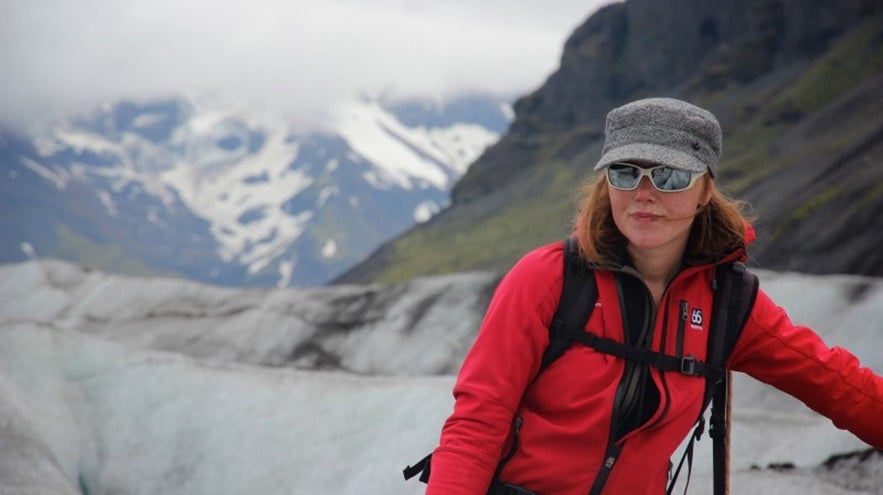
Following Solheimajokull, the next most popular glacier to hike is Svinafellsjokull in the Skaftafell Nature Reserve, an incredibly beautiful place of forests, waterfalls, mountain peaks, and glacier tongues. This ice cap is also very close to other incredible wonders, such as the Jokulsarlon glacier lagoon.
A hike on the ice here is just one of many wonderful activities the area offers.
The advantage of hiking Svinafellsjokull is thus largely its location. In clear weather from the top of the glacier, you can expect awe-inspiring views that will stay in your memory for life. Svinafellsjokull is also renowned for its dramatic ridges, making a walk on the ice more beautiful and impressive.
- See also: Skaftafell | A Hiker's Paradise
Glacier Tours on Snaefellsjokull
A more challenging glacier hike occurs throughout the summer at Snaefellsjokull on the Snaefellsnes peninsula. You will get to reach the very top of the mountain, where you can see its famous twin peaks.
These peaks are featured in Jules Verne's novel ‘A Journey to the Centre of the Earth’; it is said that the shadow of one will point to a cave that leads to the planet's depths. Those who love literature, therefore, will enjoy seeing the place where the novel’s adventure begins.
You need not be a fan of the book, however, to find great appeal in this hike. In clear weather, your views from the top will be unmatched; you may see across the ocean to the mountains of the Westfjords and Reykjanes Peninsula.
This excursion, however, should only be attempted by those confident in their fitness; it is the most challenging glacier hike available on a day tour in Iceland.
The Snæfellsnes Peninsula is nicknamed ‘Iceland in miniature’ because of the enormous diversity of scenery and landmarks along its 90-kilometer stretch, adding vastly to any excursion in the region. Snæfellsjökull is often referred to as ‘the crown jewel of the peninsula.’
- See also: The Magical Snaefellsnes Peninsula.
Glacier Tours on Vatnajokull
The aforementioned Svinafellsjokull is connected to the larger Vatnajokull ice cap; as Vatnajokull is so vast, however, there are other places on it that you can hike.
They will present you with snowscapes unmatched on any other tour. Vatnajokull covers 8% of Iceland’s surface, including dozens of its volcanoes, such as the ever-rumbling Bardarbunga, making a hike along it an experience unlike any other.
A more reliable and often more affordable way to explore Vatnajokull is to book a snowmobiling tour. There's also a popular ice cave there, which you can visit with this ice caving tour in Vatnajokull, which starts from Jokulsarlon glacier lagoon.
Other Glaciers in Iceland
Langjokull glacier is less popular amongst operators for hiking tours, despite its proximity to Reykjavik, but is well-known for its ice tunnels and snowmobiling trips.
Unlike the ice caves at Vatnajokull, these are not natural, having been carved into the sturdiest part of the glacier. The ice tunnels are the only place in the world where you can reliably and safely walk inside a glacier at any time of the year.
This glacier’s proximity to the Golden Circle, being visible from the Gullfoss waterfall when the weather is clear, means that snowmobiling upon it is also often combined with a Golden Circle tour.
Solheimajokull, Skaftafellsjokull, and Langjokull are the glaciers most visited, but it is possible to explore many others by different means. Myrdalsjokull, Iceland’s third largest glacier, can be explored by snowmobile. You can also explore an ice cave on this glacier, with departures leaving from Reykjavik and Vik.
You can also take a super-jeep tour to the top of the notorious peak of Eyjafjallajokull. This is the glacier that covers the volcano which erupted in 2010, causing widespread disruption to air travel.
Wherever you choose to embark on your glacier adventure, Iceland’s glaciers are a marvel of nature, capturing beauty and history within their icy depths. Shaped by volcanic ash, immense pressure, and changing climates, these ancient formations offer a glimpse into Earth’s past while creating breathtaking landscapes.
From electric blue ice caves to vast glacier lagoons, each feature tells a story of resilience and wonder. Whether you’re seeking thrilling hikes, scenic glacier views, or a quiet moment to reflect, Iceland’s glaciers promise an unforgettable journey into the beauty and mystery of our planet’s frozen giants.
Did you enjoy our article, The Ultimate Guide to Glacier Tours in Iceland? What types of glacier tours did you participate in while in Iceland, and what would you recommend for future visitors? Make sure to leave your thoughts and queries in the Facebook comments box below.

